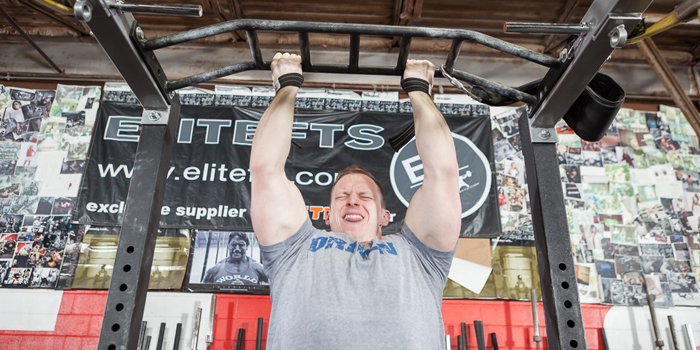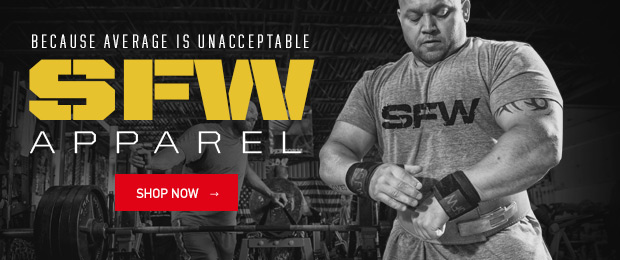
These bodyweight exercises are listed in no particular order. I put this list together because there are many bodyweight exercises that, based upon their progressions, can be a fundamental part of any strength training program. These exercises can be performed by the most basic beginner at the lowest level possible, all the way up to the most advanced lifter. I used many of these exercises for personal training clients of mine that I had years ago that hadn't touched a weight their entire life and were 50, 60 years old. I've also used them with kids. They can also be used for the most advanced lifters in the sport of bodybuilding, powerlifting, strongman and other professional athletes. No matter what level of training you're doing, there is a way to make these work for you.
Barbell Push-Ups
When I say barbell push-ups, I'm talking about putting the barbell into a power rack so the barbell won't move. The reason I did not say push-ups is because I don't want an open palm position. This places strain on the wrists and it also takes the forearms, to some degree, out of the movement.
I like bodyweight movements that I can progress upon. I'm not saying you can't progress upon a push-up, but you can progress further upon a barbell push-up where your hand is holding onto a barbell. A lot of people may not be able to lay on the floor and get one repetition with a barbell push-up. They can start on their knees. If they can get a repetition on their knees, then you simply just put the barbell in the j-cups and take it up higher in the rack. You can take it up to a high enough level that they're kneeling on the floor, and the J-cups are at chin level.
MORE: A Push-Up Is Not Just a Push-Up
That would be the easiest progression. Then you progress down the rack, moving the barbell close and closer to the floor. When your progress even further on the harder end, you can start changing the angle even further by putting your feet on a box behind you so that your legs are higher than your hands. Then add chains on your back. I've seen lifters use up to 300 pounds of chains crossed over their back. If you don't have chains, use a weight vest. There is a vast difference between the very beginning easy progression and the high-end difficult progression.
Split Squats
I'm going to list this bodyweight exercise as split squats but it actually takes the form of a lot of different single-leg type movements. The lowest progression would be a low box step up. Then, you would move the step up from there. From there, you can progress onto a backward step lunge, where you are in a standing position and you bring one leg back and squat down with the other. Then progress in to a front-step lunge, and then into a Bulgarian Split Squat with your back leg elevated. Then you can add weight vests, chains, or even barbells. Instead of a Bulgarian Split Squat, you could choose to do walking lunges or regular lunges and progress them the same way with weight vests, chains, and barbells. Once again, a wide range of variations through progression to be able to work from the very, very beginner level to the highest, most advanced athlete.
Glute-Ham Raises
Yes, I do understand that you're going to need a GHR to be able to do this. I do understand that holding somebody's ankles and having them do a manual hamstring curl is not really the same thing as a glue-ham raises, but I'm still sticking the glute-ham raise in this list, because this is about finding the best bodyweight exercises to incorporate into a strength building program. With that in mind, I do feel a glute-ham raise is better than a manual hamstring curl because the knee drops at the same time as the hip moves so you're getting the hamstring contracting from both origin and insertion.
MORE: 16 Methods to Optomize Your Glute Ham Raise
The very basic level of this would be to elevate the front end of the glute-ham so it's higher than the back end, allowing for leverages to move the client much easier than they would be able to move themselves. If you're using a floor glute-ham, such as Brian Schwab's, then you would use bands attached around the top of a power rack to be able to deload. To progress and make a GHR more difficult, elevate the back end so that more weight is shifted forward. You can then hold med balls, add chains, or even put a SS Yoke Bar on your back. It's not hard to find a way to progress to insane levels here. Just like the previous exercises, you can begin at a very, very basic level and progress to a very, very advanced movement.
Leg Raises
Of all leg raises, hanging leg raises are the best. With that movement, a lot of things happen. You open up for hip flexion. You stretch the abdominal wall at the start of the movement, and then as you raise your legs up, keeping them straight, you go into full flexion. You can even bring your legs all the way up to the top of the bar. Everything in the abdominal region is contracted, as well as some stretching of the spine and an eccentric contraction of the spine on the way down.
Not everybody is going to be able to start with the hanging leg raise. They're going to have to start with knee raises, using a bench, leaning back, holding the bench, bringing their knees into the torso, and kicking back up. Or they will do the hanging leg raise where all they're going to do is to pull their knees up. Then from there, progress into the straight leg raises and go on to straight leg raises with weights being held between the feet.
The Squat
The squat is a fundamental basic exercise. It's also a bodyweight exercise. For a lot of clients that I have had to work with, there were two exercises that everyone would start with and then branch out from there: the barbell push-up and the squat. With the squat, some people would have to start with just a basic box squat because they didn't have the strength to be able to maintain proper position for a regular standing bodyweight squat.
The lowest progression is a box squat where you stop on the box and realign position to be in the right position before coming back up. This works well if you struggle to keep the right position on the way down. Once you no longer need to fix position in the bottom, you can move into a goblet squat or a kettlebell squat. Then you can add a weight vest and finally move on to a barbell squat. We know where you can go from there.
Extensions
The best way for me to define the extensions is this: much like the barbell push-up, the extensions are going to go in a power rack or a Smith machine if you don't have a power rack. Put it at about waist level. Step back. Grab the bar like you going to push-up but, instead of doing a push-up, just drop-down like you going to do a tricep extension to your chin or nose, and then tricep extension back out.
The progressions from this can start at the high level. I've had people where I've had to start them at eye level and then, obviously, as you move down to the floor position or the bottom position in the rack, or the Smith machine, the harder it's going to get. You can bring your feet up again as you did with the push-ups and start adding weight vests and so forth, just like the push-ups.
Honorable Mentions
There are a of couple exercises that I have mentioned as honorable mentions that really don't make my list but I'm going to include them because they do make a lot of other people's lists. The reason they don't make my list is that, over my three decades of training, one question that I've always asked lifters that have been in their 40s, 50s, 60s, and 70s is, "What exercises can you no longer do?"
As we age, movements get taken away from us. Maybe not all of us, but the majority of us, aren't able to keep doing the exercises we could when we were younger. It's like the Gods of Valhalla's way of smacking us with a dose of reality. Every so often, you realize, "Oh shit, I can't do this anymore." There's a couple of bodyweight movements that every single time I've asked this question, they've always been on the list.
Chins and Dips
While I think these are great bodyweight movements, I do have to ask why everybody with a very long training age can no longer do them because of either shoulder problems or elbow problems. Because of that, those are two exercises that I personally always try to avoid or do not use very frequently in my training program. There are a lot of barbell exercises that they would mention as well, which I can save for different post at a different time. From a bodyweight standpoint, I understand why a lot of people put chins and dips in their training; there are progressions for each of these as well.
With the chins you can have someone behind you help deload the weight. There are also machines to help deload bodyweight. You can use bands for the same purpose. There's also the fat man pull-up, where you put a barbell in the power rack at waist level, lie on the floor, and pull your chest to the bar. I absolutely love this exercise because it allows you, and teaches the client, to pull their elbows back as far as they can when they train their lats and to try to get the bar to touch their chest. It's a great reinforcement tool for power lifters and it's also great for bodybuilders because they need to learn how to pull the elbows back. I actually don't see that as being a chin, but it is part of a chin progression for those who cannot do chins.
For the dips, as far as the progression goes, it's pretty much the same. You have the machines. They can allow you to take the weight off. You have the ability to use bands to be able to deload. You have the ability for somebody to stand behind, tuck their hands, and lift your feet. You can also do quarter reps, half reps, and work until you can do full reps. There are a lot of ways to progress.











1 Comment